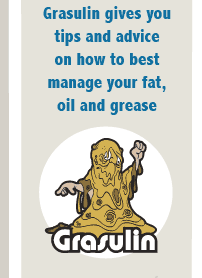 |
Did you know 1 gallon of oil could pollute up to 1,000,000 gallons of water?
The biggest problem a restaurant has is the grease. The discharge of FOG (FATS, OIL AND GREASE) into the sewage system is prohibited and puts at risk our habitat and our island. Grease, fats, oils, butter, etc. are some examples of lipids (components that don't mix with water) which stick to the piping lines and the grease trap creating clogs.
COMMON MISCONCEPTIONS:
Foodservice operators are in the business of supplying the public with delicious, safe food under profitable conditions and are not in the business of wastewater treatment. Accordingly, there is a lack of knowledge in managing FOG generated from foodservice operations, which has led to some misconceptions:
Misconception #1: "Grease traps are self-maintaining wastewater treatment devices.
" Foodservice establishments unknowingly think of grease traps in the same light as wastewater septic tanks, viewing them as treatment systems that only have to be maintained and serviced when a problem occurs. "I've been here for eleven years," said one restaurant owner. "I've never even looked in the thing (grease trap), never had a problem with it, it's always worked great." This misconception not only leads to the discharge of an abundance of FOG into the sewage system, but in some cases foodservice operators with no outlet for used fryer oil simply pour it down kitchen drains with hot water thinking the grease trap will "treat" the oil. Grease traps are not systems that treat wastewater: they are simple separation devices that are designed to retain FOG and solids long enough for them to be removed by a grease trap service company. The most important aspect to remember is that as more spent FOG is retained in a grease trap, the more the separation efficiency diminishes. Because spent FOG fills a grease trap from the top down, it is hard to determine the fullness of a grease trap on visual inspection. A trained professional should determine the proper frequency of cleaning.
Misconception #2: "A grease trap and a grease barrel are the same."
A grease trap is a separation device used to collect brown grease and food solids from the kitchen wastewater. The grease barrel is used to store used fryer oil, which is known as yellow grease. If we supply the barrel, we will normally collect the old frying grease at the same time the grease trap is cleaned.
Misconception #3: "Kitchen floor drains are the largest source of grease trap waste in a foodservice establishment."
Contrary to popular perception, foodservice kitchen floor drains receive relatively little waste and have minimal impact on grease intercepting equipment. Most FOG released to the waste stream in foodservice kitchens is generated from equipment associated with dishwashing. Multi-compartment pot washing sinks, pre-rinse stations, and automatic commercial dishwashers generate more grease trap waste than any other source. On-site testing in commercial kitchens has shown that 90% of grease trap waste is created in these dishwashing areas.
Misconception #4: "Once grease is down the drain, it is no longer your problem."
This "out of sight, out of mind" misperception can create costly problems. Aside from the interruption of your business operations should your grease trap or drains back up, AAA (AUTORIDAD DE ACUEDUCTOS Y ALCANTARILLADOS) can impose heavy fines on foodservice operators that fail to properly manage their wastewater.
Misconception #5: "All companies cleaning grease traps are the same."
There are many "fly-by-night" grease trap service companies that charge a low price and do not properly perform the cleaning. Commonly, these companies remove the contents of yours and grease traps from other establishments and then empty the "gray water" into your grease trap; the gray water contains suspended grease, which flows into the city sewage system and eventually causes a blockage. Reputable companies, such as WARCO, remove the entire contents of the grease trap and dispose of it at a permitted facility.
Ask to see your grease trap company's permits for operations and disposal and make sure to always have a trained employee present when your grease trap is being cleaned.
MAINTENANCE & CLEANING:
A grease trap regularly should be checked and thoroughly cleaned to ensure its proper performance. Backups, odors and drainage problems are signs that a grease trap is not functioning correctly.
By far the greatest factor affecting the amount of FOG released to the waste stream in any foodservice establishment are the cleaning and maintenance techniques of the kitchen staff. The care taken by staff to dry scrape leftover food into the garbage and pour spent grease into a grease drum is key to reducing the loading of grease traps. Practices that are encouraged regarding cleaning and maintenance of grease traps include:
- Dry cleanup - don't use the hose as a broom! Dry scrape into the garbage all plates, pans, utensils, and work surfaces (including the floor) before cleaning with water.
- Ensure that staff does not empty spent fryer grease into the drains or the grease trap.
- Prevent spills - spills create waste that can find its way into the grease trap, needlessly wastes ingredients, and costs time for cleanup.
- Train all staff on the location, purpose and function, and proper maintenance of grease traps on a frequent basis.
- Ensure that grease trap maintenance is conducted on a regular schedule and is written into policies and procedures for the facility.
- Your trained representative should be present during any cleaning or pumping performed by a contractor. This safeguard permits management to ensure that the grease trap is properly cleaned (i.e., the entire contents pumped and the sides pressure washed or scraped) and to respond appropriately to any questions about the services performed.
- Pump out schedules should be properly established and strictly followed.
- Never "hot flush" (continuously run hot water) the grease trap because the heated, liquefied grease will be flushed down the sewer. While hot flushing may divert the need for pumping, it may create a blockage downstream causing the grease trap to overflow.
|
 |




